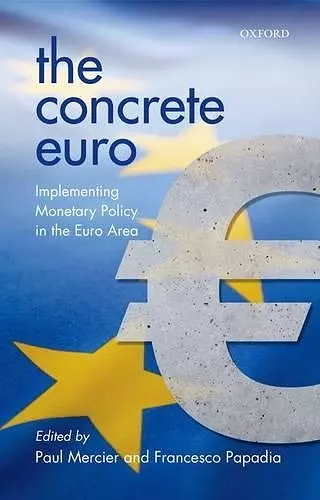The Concrete Euro
Implementing Monetary Policy in the Euro Area
Paul Mercier editor Francesco Papadia editor
Format:Hardback
Publisher:Oxford University Press
Published:27th Jan '11
Currently unavailable, and unfortunately no date known when it will be back
This hardback is available in another edition too:
- Paperback£43.49(9780198713647)

The euro area's framework for monetary policy implementation was introduced in 1999. Eleven years on, this volume examines the theoretical and historical underpinnings of the framework, how it has fared in practice, and what challenges it is likely to face in the future. The technology serving the implementation of monetary policy has historically been the exclusive preserve of a narrow group of specialists but the recent global financial crisis brought the issue into the public eye, as the supply of base money exploded while inflation risked turning into deflation. This book addresses all the aspects of monetary policy implementation, with particular emphasis on the European Central Bank and the euro, allowing a more informed assessment of a neglected, but important, aspect of economic life, and a better understanding of the exceptional developments brought about by the financial crisis. Written by the leading money market operators at the European Central Bank who were involved in creating and implementing the framework, and who are still managing monetary policy implementation at the Bank today, this book provides a rare insider account of how the framework has evolved, how it works in practice, and the challenges of monetary policy implementation going forward.
During the opening stages of the financial crisis, the ECB provided the necessary liquidity to euro-system banks more smoothly than other Central Banks. This book describes how that was done. More recently, a second leg to the crisis, in the guise of the sovereign debt crisis in certain peripheral countries of the euro-zone, has blown up. The operational reactions of the ECB to this are also covered, up until mid-2010. This book provides a unique insight into the ECB's monetary operations, both in normal and in crisis conditions. A 'must read' for all those concerned with Central Banking, crisis management and the inner workings of the euro-system. * Professor Charles Goodhart, London School of Economics *
Paul Mercier and Francesco Papadia, longstanding practitioners and thinkers in this area, have provided a badly needed service in bringing together their thoughts on central banks' monetary operations. As the liquidity crisis broke in mid-2007, central banks everywhere found themselves needing to explain how their open market operations, discount window facilities and lender of last resort functions operated, and how they fitted into monetary policy and financial stability mandates This book tackles that vital task for the special circumstances of the euro area. Market participants and commentators on central banking should read it. * Paul Tucker, Deputy Governor, Financial Stability, Bank of England *
These four papers by six ECB economists provide the most systematic and detailed look at how the European Central Bank has implemented its monetary policy, both during the all-too-short "normal" times of the Bank's initial years and then during the 2008-10 crisis period. The analysis is clear and elegant, and the empirical work provides useful insights as well. Anyone seriously interested in how monetary policy is actually carried out - either by the ECB or by other central banks - will want to read these papers. * Benjamin M. Friedman, William Joseph Maier Professor of Political Economy, Harvard University *
ISBN: 9780199557523
Dimensions: 240mm x 170mm x 28mm
Weight: 766g
416 pages